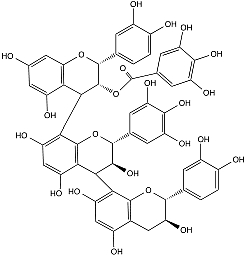Polymers of flavan-3-ols; the larger structures are condensed tannins. Catherine Harvey, 2015.
Proanthocyanidins play an important role in wine; with the capability to bind salivary proteins, these condensed tannins strongly influence the perceived astringency of the wine. These compounds are typically present in levels of 300mg/L1 in red wine, though enological processing can affect the final concentrations. Proanthocyanidins are constructed from monomeric flavan-3-ols, which is considered one of the largest and most functional subclass of flavonoids found in foods and beverages2.
In grapes, the composition of proanthocyanidins varies according to the tissue type; the grape skins typically contain higher mean degrees of polymerization, and the seed proanthocyanidins contained in the outer coat and endosperm often have lower average molecular weights, which has been correlated to a bitter taste3. Moreover, the composition and accumulation of condensed tannins during berry development can be highly influenced by both the region the grapes are grown and the vineyard management practices.
The final composition and concentration of proanthocyanidins can be further impacted by the time period and temperatures of the maceration; the increasing alcohol levels; the cap management techniques for maintaining contact between the juice, skins, and seeds; the choice of yeast strain; the selection of processing aids to refine the clarity; and the stabilization of the wine. Condensed tannins continue to evolve through the aging process as favorable reactions with oxygen propagate. Cross-linking reactions with anthocyanins in the presence of acetaldehyde and numerous polymerization mechanisms act to stabilize the color and decrease the perceived astringency of the wine.
The chemical composition of these compounds also contributes to the established health effects of wine. With the capabilities of acting as antiatherosclerotic, immunologic, antimicrobial, and antiviral agents, as well as potent antioxidants, proanthocyanidins are being considered as potential therapeutics to alleviate various chronic diseases.

[1] Gu, L., Kelm, M. A., Hammerstone, J. F., Beecher, G., Holden, J., Haytowitz, D., Gebhardt, S., and Prior, R. L. (2004) Concentrations of Proanthocyanidins in Common Foods and Estimations of Normal Consumption, The Journal of Nutrition 134, 613-617.
[2] Aron, P. M., and Kennedy, J. A. (2008) Flavan-3-ols: Nature, occurrence and biological activity, Mol. Nutr. Food Res. 52, 79-104.
[3] Vrhovsek, U., Vanzo A., and Nemanic, J. (2002) Effect of red wine maceration techniques on oligomeric and polymeric proanthocyanidins in wine, cv. Blaufränkisch, Vitis 41, 47-51.
